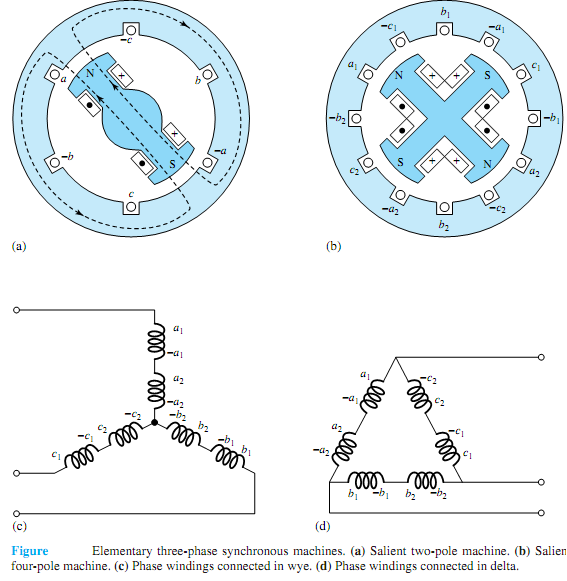Q. Principle of Three-phase synchronous machines?
In fact, with very few exceptions, three-phase synchronous machines are most commonly used for power generation. In general, three-phase ac power systems, including power generation, transmission, and usage, have grown most popular because of their economic advantages. An elementary three-phase, two-pole synchronous machine with one coil per phase (chosen for simplicity) is shown in Figure (a). The coils are displaced by 120 electrical degrees from each other in space so that the three-phase voltages of positive phase sequence a-b-c, displaced by 120 electrical degrees from each other in time, could be produced. Figure (b) shows an elementary three-phase, four-pole synchronous machine with one slot per pole per phase. It has 12 coil sides or six coils in all. Two coils belong to each phase, which may be connected in series in either wye or delta, as shown in Figures (c) and (d). Equation can be applied to give the rms voltage per phase when N is treated as the total series turns per phase.

The coils may also be connected in parallel to increase the current rating of the machine. In actual ac machine windings, instead of concentrated full-pitch windings, distributed fractional- pitch armature windings are commonly used to make better use of iron and copper and to make waveforms of the generated voltage (in time) and the armaturemmf (in space) as nearly sinusoidal as possible. That is to say, the armature coils of each phase are distributed in a number of slots, and the coil span may be shorter than a full pitch. In such cases, Equation is modified to be where kW is a winding factor (less than unity, usually about 0.85 to 0.95), and Nph is the number of series turns per phase.

Special mechanical arrangements must be provided when making electrical connections to the rotatingmember. Such connections are usuallymade through carbon brushes bearing on either a slip ring or a commutator, mounted on-but insulated from-the rotor shaft and rotating with the rotor. A slip ring is a continuous ring, usually made of brass, to which only one electrical connection is made. For example, two slip rings are used to supply direct current to the field winding on the rotor of a synchronousmachine. A commutator, on the other hand, is amechanical switch consisting of a cylinder formed of hard-drawn copper segments separated and insulated from each other by mica.